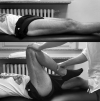The Reamer-Irrigator-Aspirator (RIA) System for the treatment of aseptic femoral nonunions: Report of two cases and literature review
- PMID: 36213618
- PMCID: PMC9534743
- DOI: 10.52965/001c.37889
The Reamer-Irrigator-Aspirator (RIA) System for the treatment of aseptic femoral nonunions: Report of two cases and literature review
Abstract
Femoral shaft nonunions are disabling complications of fractures, with relevant socioeconomic and psychological impact. The incidence of femoral shaft nonunions is not negligible, ranging between 1% and 10% after intramedullary nailing, but can exceed 20% in case of subtrochanteric fractures. Treatment options are influenced by pathomechanical, anatomical, and clinical factors. Hypertrophic nonunions are usually treated by enhancing stability of fixation, while atrophic nonunions require additional biological stimulation to achieve bone union. The Reamer-Irrigator-Aspirator (RIA) System® was developed to reduce intramedullary pressure and heat generation during intramedullary reaming, thus preventing thermal necrosis and decreasing the risk of fat embolism. The RIA System allows to provide large volumes of high-quality morselized autologous bone, that has shown high osteogenetic and osteoinductive properties. Therefore, its use has been expanded as a valuable source of autologous bone graft for the treatment of large bone defects of different nature. In this article, we present two cases of complex femoral nonunions treated with the use of the RIA System. A review of the published literature on the treatment of femoral nonunions with RIA was also performed. Core tip: In case of atrophic nonunions, the RIA System can be used to obtain biologically active tissue to enhance bone healing. Despite the absence of high-quality studies focused on femoral nonunions, the efficacy of RIA is well-known and orthopaedic surgeons should be aware of this powerful tool.
Keywords: aseptic nonunion; autologous bone graft; fracture nonunion; reamer-irrigator-aspirator; ria system.
Conflict of interest statement
The authors declare no conflict of interest.
Figures

Comminuted supracondylar fracture of the right femur in a 35-year old man.
Postoperative radiographs after internal fixation with plate and screws; synthetic bone chips were used to fill a bone defect in the postero-medial region (arrows)

One year after index procedure: freshening of the nonunion site with insertion of a tricortical autograft from the iliac crest and morselized cancellous allograft.
Two years after index procedure: persistent nonunion with plate rupture.

Postoperative control after plate revision and nonunion grafting with morselized bone harvested with the RIA System.
X-rays showing bone union 10 months after the RIA procedure.


Multifragmentary subtrochanteric fracture of the right femur in a 27-year old man (case 2).
Unsatisfactory reduction and fixation with a cephalomedullary nail (see text for details).
Early revision with shortening of the femur and cerclage of a diaphyseal fragment.

Nonunion with nail breakage (arrowheads) 7 months after index procedure.
Revision osteosynthesis with plate and morselized bone graft harvested with the RIA System.



Similar articles
-
Safety and efficacy of a novel retrograde route for femoral bone graft harvesting by Reamer-Irrigator-Aspirator: a pilot study on 24 patients.Patient Saf Surg. 2022 Jan 7;16(1):2. doi: 10.1186/s13037-021-00315-4. Patient Saf Surg. 2022. PMID: 34996503 Free PMC article.
-
Reamer-irrigator-aspirator bone graft and bi Masquelet technique for segmental bone defect nonunions: a review of 25 cases.Injury. 2010 Nov;41 Suppl 2:S72-7. doi: 10.1016/S0020-1383(10)70014-0. Injury. 2010. PMID: 21144933
-
Protective effects of new femoral reaming techniques (Reamer irrigator aspirator, RIA I and II) on pulmonary function and posttraumatic contusion (CT morphology) - results from a standardized large animal model.Injury. 2021 Jan;52(1):26-31. doi: 10.1016/j.injury.2020.10.027. Epub 2020 Oct 6. Injury. 2021. PMID: 33046248
-
The Reamer-Irrigator-Aspirator System: A Review.Surg Technol Int. 2016 Oct 26;29:287-294. Surg Technol Int. 2016. PMID: 27728952 Review.
-
Reamer Irrigator Aspirator bone graft harvesting: complications and outcomes in an Asian population.Injury. 2015 Oct;46(10):2042-51. doi: 10.1016/j.injury.2015.07.027. Epub 2015 Jul 29. Injury. 2015. PMID: 26253387 Review.
References
-
- 1. Winquist RA, Hansen STJ, Clawson DK. Closed intramedullary nailing of femoral fractures. A report of five hundred and twenty cases. J Bone Jt Surg. 1984;66(4):529-539. doi:10.2106/00004623-198466040-00006 - PubMed
-
- 2. Powell J, DeGroote R, Seidel J, et al. Nonunion following intramedullary nailing of the femur with and without reaming: results of a multicenter randomized clinical trial. J Bone Jt Surg. 2003;85(11):2093-2096. doi:10.2106/00004623-200311000-00005 - PubMed
-
- 3. Pihlajamäki HK, Salminen ST, Böstman OM. The treatment of nonunions following intramedullary nailing of femoral shaft fractures. J Orthop Trauma. 2002;16(6):394-402. doi:10.1097/00005131-200207000-00005 - PubMed
-
- 4. Gelalis ID, Politis AN, Arnaoutoglou CM, et al. Diagnostic and treatment modalities in nonunions of the femoral shaft. A review. Injury. 2012;43(7):980-988. doi:10.1016/j.injury.2011.06.030 - PubMed
-
- 5. Green J. History and development of suction-irrigation-reaming. Injury. 2010;41:S24-S31. doi:10.1016/s0020-1383(10)70005-x - PubMed
LinkOut - more resources
Full Text Sources

